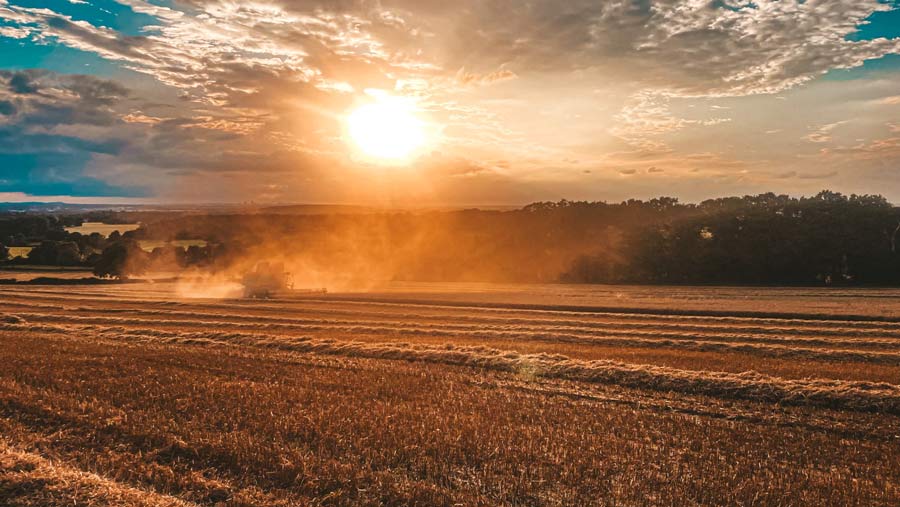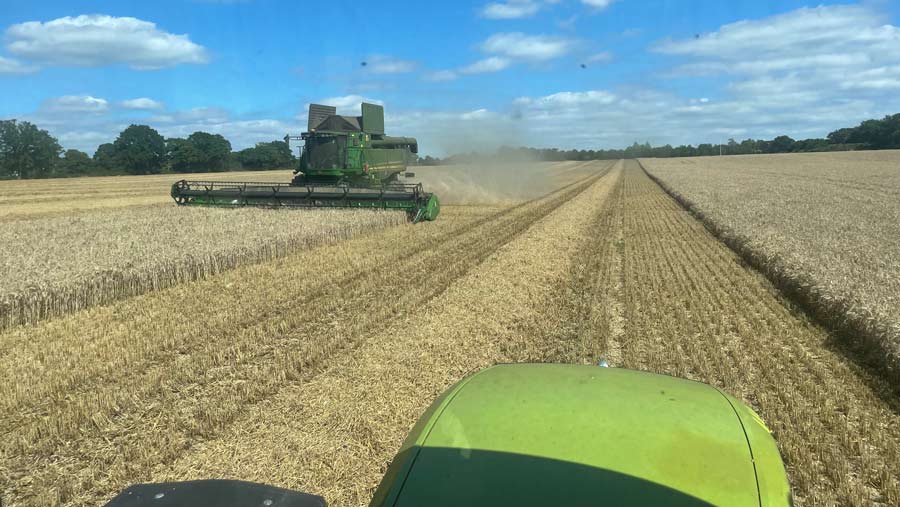Harvest 2023: Slow progress in snatch and grab harvest
 © Charlie Beaty
© Charlie Beaty Northern Ireland reports a smooth harvest despite showers, something Irish farmers are used to during harvest, while wheat in England has lost its shine to the elements.
County Armagh
In the east of Northern Ireland, 160ha of Graham winter feed wheat was first harvested on 8 August and is predicted to be completed in a couple days at Acton House Farm near Poyntzpass.
“We usually start in mid-August,” says Simon Best.
See also: Why wheat drill dates should be delayed this autumn
So far, yields have averaged 8.6-9.9t/ha, with an average specific weight of 74kg/hl. “One exceptional block was close to 12t/ha,” he adds.
The earlier established wheat has had the high-end yield. “The wheat ripening early has taken the pressure off,” says Simon, who reports wheat harvest to be 60-70% through in his area, while spring barley has suffered due to late planting.
Simon’s 90ha of oilseed rape comprising Ambassador, Auckland, and Accacia were consistently excellent in performance, yielding 4.4-4.9t/ha. Average moisture content, when cut, was 10-15%, and dried down to 9%.
Next to combine will be 80ha of Mascani winter oats, which have been patchy all year in the field and Simon is not expecting much, but estimates 6.2t/ha. He also has another 60ha of Husky spring oats left to cut.
Lincolnshire
Heading to the east of England, David Hoyles at Monmouth Farm near Long Sutton has cut 230ha of winter wheat comprising Graham, Skyscraper, Redwald, Oxford and Dawsum. With just a couple of fields left to complete, he has estimated average yield at 11.5t/ha.
“Graham is at the top of the tree, it missed the worst of the weather during maturity,” says David.
Flat crops didn’t help his wheat yield, which is down by 12-15% on the 10-year average.
Dawsum went flat in one field, but was generally not too bad on performance. And despite Redwald looking big-eared, it was disappointing. Crops combined at an average moisture content of 14%.
David is concerned about the specific weights of flat crops, but says that blending the flat crop with the standing crop could help with that.
North Warwickshire

© Charlie Beaty
In the Midlands at the Dairy Farm near Meriden, 20ha of February-drilled Mascani winter oats are expected to be combined in a of couple weeks.
Cut so far is 7.3ha and 61ha of milling wheat varieties Crusoe and Skyfall, respectively, yielding 7.4/ha at 13-14.5% moisture, but with some over 14.5% going through the dryer.
“Quality is of concern, the dry May and June meant it dried early so it went black,” says Charlie Beaty.
The 17.7ha of hybrid winter barley Kingsbarn has also been completed with a yield of 7.4/ha. “We snatched the barley in a dry 48-hour window, then the straw had rain for a week,” she adds.
Oilseed rape has been a poor, but better than expected after it battled flea beetle in the autumn – as well as slugs and pigeons. The 16.2ha of oilseed rape yielded around 3.2t/ha at an average moisture content of 9%, with some needing drying.
“There was hedge mustard within the oilseed rape that slowed down harvest,” says Charlie. “We have light land that doesn’t give record-breaking yields. It’s a low-input, low-output system.”
Somerset
Further south at Manor Farm near Radstock, 54.6ha of winter feed barley has been cut, yielding 8.9t/ha initially. “We cut 20.2ha of oilseed rape in between combining winter barley,” says James Francis.
His Aurelia oilseed rape yielded 3t/ha and was cut at 8-10.5% moisture content, and delivered to United Oilseeds to dry.
Once the oilseed rape harvest was finished, James went back to the feed barley and cut into his six-row hybrid, Kingsbarn, which yielded 6.9t/ha and was all dry ready to go to Cefetra Wessex.
On Tuesday 15 August, James started his 101.2ha of winter wheat, which is yielding 8.6t/ha, so far.

